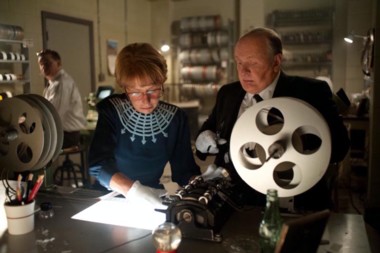In the history of film, the introduction of sound must reign as the biggest turning point. Much as the microphone gave us the breathy crooning of Bing and Sinatra instead of the bombast of their vaudeville predecessors, talkies gave us—once we worked through the novelty of it all—the ability to use audio as another storytelling device: we had always had soundtracks, but now we could hear the sad inflections in the voice of a pining lover, or the laughter of children at play. It was a new world that we still haven’t fully explored.
Along the way, there have been sounds that have become lodged in our collective subconscious: the “Wilhelm Scream,” a strangled exclamation first used in a 1951 Gary Cooper film, has gone on to play a part in hundreds of movies and television shows, called to action whenever someone is shot with an arrow, pushed off a cliff, or devoured by piranhas. (Or all three, as I’m sure has happened in some B-movie somewhere.) Likewise, the heavy, claustrophobic breathing of slasher film killers has become a shorthand for horror in general.
But of all the sounds that have wormed their way into our heads and hearts, few have had the impact of Israel Baker’s violin. Chances are you don’t know the name, but you would recognize his most famous work in a heartbeat, for it’s Baker’s violin that leads the stabbing, screeching attack that punctuates the infamous shower scene in Psycho.
This week, director Sascha Gervasi’s new film Hitchcock comes to the Valley to tell the story behind it all. Starring Anthony Hopkins as the famous director and Helen Mirren as his wife and collaborator Alma Reville, the film shines a light on the tumultuous production of Psycho—a film that few people in the industry were willing to get behind when it was first pitched. In 1960, Hollywood was a very different place when it came to what was allowed onscreen, and Hitchcock was walking a fine line: when a morals board official asks if there will be any “improper suggestion of nudity” in the shower scene, Hitch replies that “she won’t be nude; she’ll be wearing a shower cap.” The violins—controversial in their own way—came later.
It was Alma, to a great extent, who proved the driving force to get the film done, and Gervasi’s film, adapted from Stephen Rebello’s book Alfred Hitchcock and the Making of Psycho, gives her the due that she has long been denied. Not that she was ever looking for plaudits: a modest, self-contained woman, she seems quite content (in the film, at least) to play her role behind the scenes, leaving the spotlight to shine on the famous silhouette of her husband’s portly frame. But make no mistake about her influence. When Hitchcock remarks about the shock it will cause when he kills off his leading lady halfway into the picture—an unimaginable thing in that era—his wife, just before sinking her teeth into a crusty bit of toast, suggests immediately that he “kill her off after 30 minutes” instead.
The pair get support from Scarlett Johansson as Janet Leigh, as well as Jessica Biel, Toni Collette and Ralph Macchio in smaller roles. But the film’s secret weapon is the uncanny likeness James D’Arcy bears to Anthony Perkins.
However shocking the original was, it has survived in large part due to the lasting chill of Perkins’ performance as Norman Bates, and any film that purports to be about the making of Psycho will almost certainly fail without a good Perkins. D’Arcy is such a ringer for the actor that I had to double check the press photos. It’s not the heart of the film, but it’s a Hitchockian detail that will provide a little extra tingle down your spine.•
Jack Brown can be reached at cinemadope@gmail.com.



